Artistry meets practicality on a wet slab of concrete
by Katie Daniel | March 7, 2018 2:35 pm
 [1]
[1]by Jason Spangler
Creating an enduring structure requires careful planning for physical and aesthetic integrity. While this symbiosis of artistry and structural stability is not assured until the project is fully complete, getting there requires laying the right groundwork at the very beginning—during the planning phase.
Shortchange the planning process and a lot can go wrong. This is as true with the finished flooring installed over a concrete slab as with any other aspect of a construction project. If the expectations are not clearly specified and either the general contractor or the flooring installer moves ahead before the concrete is sufficiently dry, the outcome may well be catastrophic. Flooring adhesives may not stick properly, hardwood floors may buckle, cup, or warp, and floorcoverings may attract mold or mildew over time.
To avoid risking a flooring failure, critical details must be in place upfront—while creating the design and documenting the specifications. This is the first and sturdiest line of defense against experiencing nasty errors and omissions that have the potential to unravel one’s project and reputation.
It is important to examine many of the details that will need to be locked down, including the specified method of measuring moisture in concrete slabs. This makes it much more likely the project happens the way it should to ensure beautiful, lasting flooring.
Designing for success
Planning for a successful finished floor requires good teamwork. When architects and specifiers closely collaborate, their partnership makes certain the most appropriate methods and materials are selected for the project.
Several critical decisions should be made relating to the concrete drying process and getting the slab ready for the flooring installation. Each of these choices can impact drying and curing time. They can also minimize the risk of moisture-related flooring failure.
The Swedish Cement and Concrete Research Institute (CBI) has developed a formula to estimate minimum drying times for concrete slabs. (For more, see Howard Kanare’s second edition of Concrete Floors and Moisture, published by the Portland Cement Association [PCA] in 2008.) This formula relies on many of the variables explored in this article. It includes tables of numerical values for the following correction factors, which can be multiplied together to calculate an estimated number of days needed to dry the slab:
- water-to-cement (w/c) ratio;
- slab thickness;
- one- or two-side drying;
- ambient conditions (e.g. temperature and relative humidity [RH]); and
- curing conditions.
This information can be used to create an appropriate timeline for the project from the very beginning. An accurate estimate of reasonable drying times, based on data someone on the project team has taken time to work out, helps to avoid undue delays, budget overruns, and pressures to move ahead when the slab is not yet ready for the finished floor.
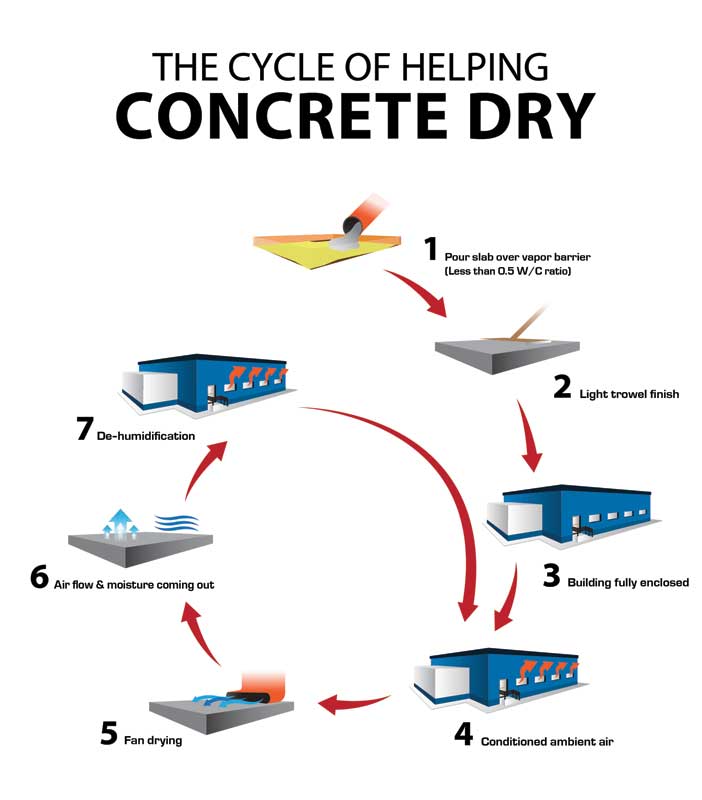 [2]
[2]Images courtesy Wagner Meters
Concrete mixture
The makeup of the concrete, specifically its w/c ratio, is the single largest variable determining the drying time needed before the flooring can be installed. Other concrete ingredients, such as the chemical admixtures, can also directly impact drying time. Specifying the makeup of the project’s concrete allows one to factor this into the anticipated drying time, thereby helping build realistic expectations about the total timeline.
Slab thickness
As the concrete slab dries, moisture moves within it and eventually evaporates into the air. The thicker the slab, the longer the time that must be allowed for it to sufficiently dry. While the maxim seems to be 28 to 30 days of drying time for each 25 mm (1 in.) of slab thickness, it is important to remember this is merely an approximation. Given the number of variables that can ignificantly affect drying time—ranging from w/c ratio to ambient conditions—one should never rely on this rule of thumb as a precise way for making drying time predictions. (Studies were conducted in the 1990s by Göran Hedenblad and others. A good source of information from this period is his “Drying of Construction Water in Concrete-drying Times and Moisture Measurement,” published in 1997 in Stockholm as part of the series, Protection of Buildings Against Moisture.)
Design components
It is important to decide during the planning phase how, and to what extent, additional materials and slab design elements (e.g. vapor retarders or curing blankets) will be employed. Their use impacts the drying time of the slab.
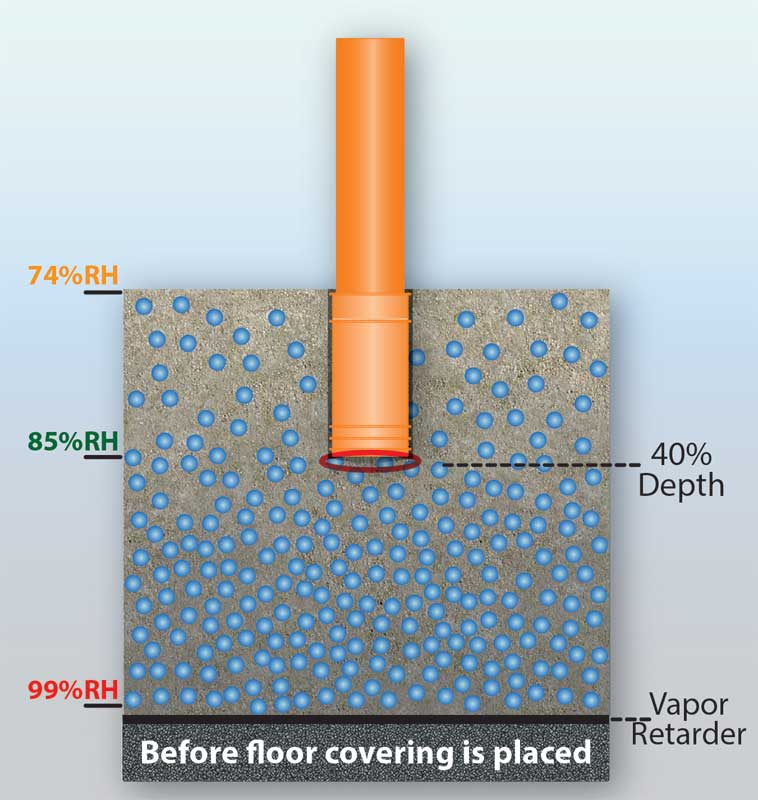 [3]
[3]For example, vapor retarders are beneficial because they prevent the slab from absorbing groundwater. However, at the same time, their use also means the moisture already in the slab now only has one route for escape. Vapor retarders are typically considered a ‘net-positive,’ but their impact on drying time has to be considered. On the other side of the spectrum, the specification of either a curing blanket or curing compound inhibits the release of moisture vapor.
Troweling
Beautiful to behold, glossy concrete surfaces are quite popular. However, using a power trowel to get a smooth surface compresses the concrete. This reduces the slab’s porous nature and closes off naturally occurring internal routes for moisture to evaporate. When employing a lightweight concrete application, the impact is even greater. Even if not using a power trowel finish, it is very important to remember the angle of the blade during troweling changes the amount of pressure being exerted on the concrete’s surface. For these reasons, the trowel finish process should be specified and also included in the calculation of the slab’s drying time and, ultimately, in the project timeline
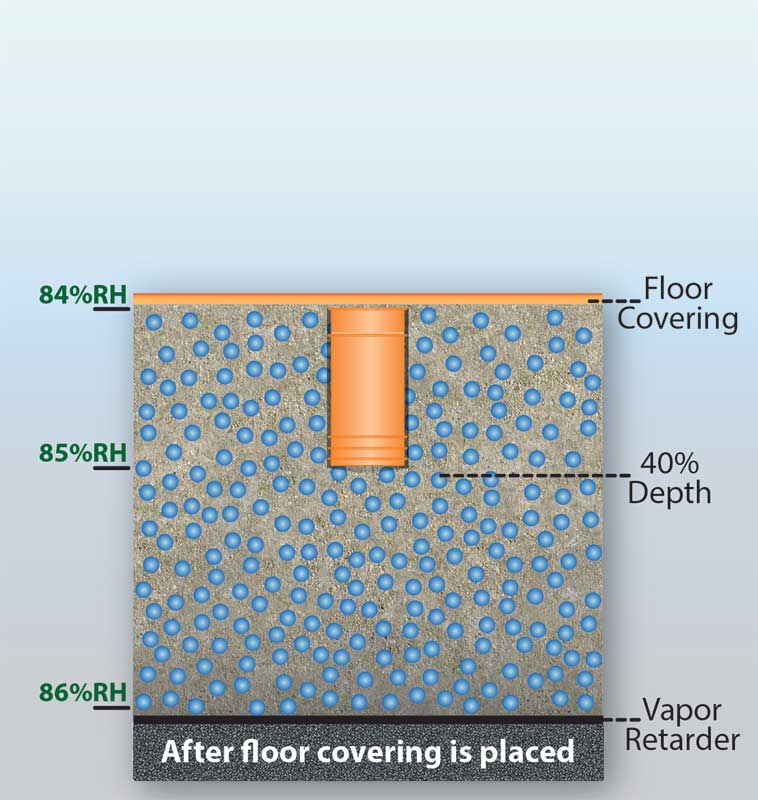 [4]
[4]Ambient conditions
The conditions under which the concrete slab dries must not be left to chance. While a slab might be exposed to weather for a time, as soon as the building site gets enclosed, a lot can be done to control the ambient conditions. Architects and specifiers can reduce the possibility of unfavorable project outcomes caused by concrete moisture by specifying what to do in relation to such conditions. One should know what conditions are expected and control them to the best degree possible—this allows a reasonable anticipation of how much time will be needed for the slab to dry sufficiently. Several different atmospheric variables should be considered.
As mentioned, concrete dries as the moisture within it evaporates. If the air is already full of moisture, as measured by RH, it cannot draw any moisture from the concrete. If the air is greater than 85 percent RH, the slab may be absorbing moisture from the air, rather than drying. Anytime the RH in the air is higher than the RH in the slab, the concrete draws moisture out of the air instead of releasing it. Consequently, it is important to control the amount of RH in the air and know the humidity level within the concrete.
The temperature of the air affects its dewpoint, which determines how much moisture the air can hold. Cold temperatures have a lower dewpoint, so they lengthen the drying process. As such, the expected air temperature for when the concrete slab is laid and allowed to dry needs to be a known entity. Additionally, one must plan ahead and decide which tools—such as fans or dehumidifiers—might be used to impact the effects of air temperature and other ambient conditions.
Further, air that does not move may let evaporated moisture resettle on the surface of the concrete. When determining how some flow will be provided to the space, whether through fans or HVAC, it is important to remember these details also impact the other ambient conditions.
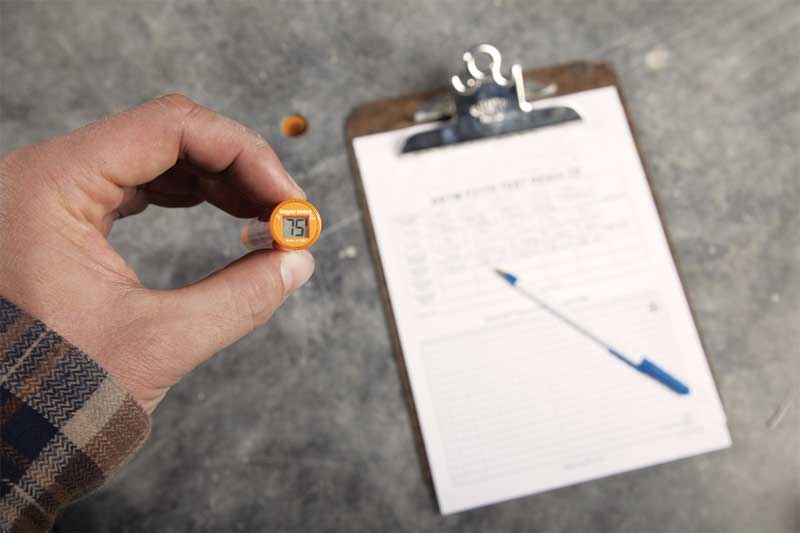 [5]
[5]Specifying the concrete moisture test
All the planning related to concrete and drying times is intended to help control the future as much as possible. However, the project team’s choices, predictions, and estimations must still come face-to-face with reality. This is why it is fundamentally important to specify the most proven and reliable concrete moisture test to get an accurate assessment of actual conditions. Without the right moisture test, the project team cannot be confident regarding the true moisture condition of the concrete; design professionals simply cannot make good decisions about how and when to move forward.
Several methods of concrete moisture testing exist. The two most commonly used are:
- the moisture vapor emission rate (MVER), or calcium chloride test, using ASTM F1869, Standard Test Method for Measuring Moisture Vapor Emission Rate of Concrete Subfloor Using Anhydrous Calcium Chloride; and
- the aforementioned in-situ RH test method, using ASTM F2170, Standard Test Method for Determining Relative Humidity in Concrete Floor Slabs Using In-situ Probes.
Each of these tests is used to evaluate the moisture condition of the concrete, but they actually measure different things. This makes them quite distinct from one another.
The MVER test measures the moisture absorption rate of calcium chloride crystals that are placed on the surface of the concrete slab. In contrast, the RH test uses electronic sensors placed at a specific depth in the slab to measure RH within it. Studies at Lund University in Sweden and elsewhere have shown the RH percentage at 40 percent depth (for a slab drying from one side) predicts the slab’s moisture condition once it is sealed by a finished floor product. (In the 1940s, this was a qualitative test for concrete moisture. Two decades later, it evolved into a quantitative test, but with no documented scientific basis for going this direction. The MVER test is still employed today simply because it is what a number of people have customarily used. However, with the growing awareness of the test’s inherent problems and lack of a scientific pedigree, it has increasingly gone out of favor.) So, do these different approaches to testing for concrete moisture actually matter?
It is important to consider where each test is taking its measurements. Measuring moisture at the surface of the slab, as is done with the MVER methodology, can be unreliable for several reasons. The surface of the slab is disproportionately affected by ambient conditions. Measurements taken at the surface also ignore what is known about how concrete dries—that is, as the moisture moves up through the slab, a gradient forms in which moisture levels typically rise with increasing depth. Measuring surface moisture is essentially taking a superficial measurement that fails to account for conditions deeper in the slab.
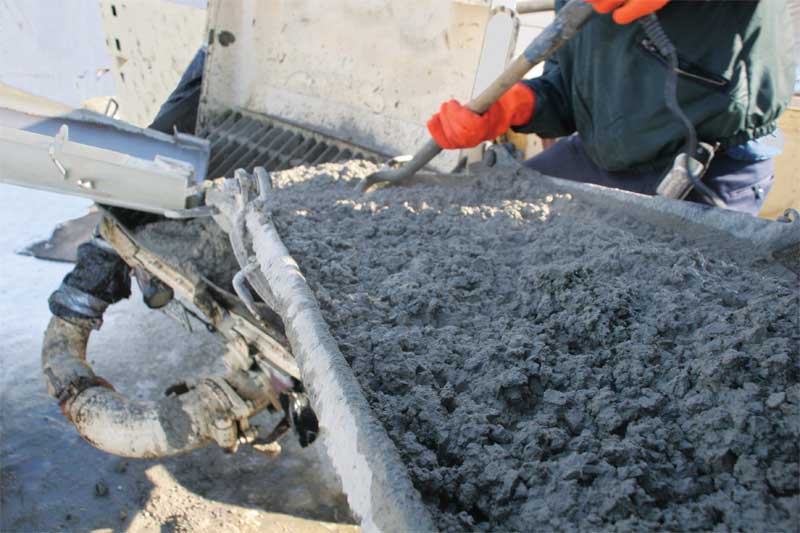 [6]
[6]Photo © iStock. Photo courtesy Wagner Meters
The RH test, on the other hand, fully accounts for the moisture gradient by measuring at a specific, proven depth inside the slab. The location of the RH test—inside the slab and not at the surface—also minimizes the influence of ambient conditions.
Another critical difference is that the MVER test returns an estimated emission rate at a specific point in time. However, unlike the RH test, this emission rate has not been shown to be a reliable predictor of the overall moisture condition of the slab once it is sealed with a finished floor product. The RH test is actually measuring how much moisture the finished floor experiences once the slab is sealed. This is because it is taken at a proven depth for measuring the slab’s moisture ‘equilibrium point.’
The moisture gradient typically existing before the flooring installation tends to disappear and then move toward this equilibrium point after installation. Since the RH test can rightly be considered an accurate predictor of the slab’s moisture equilibrium point, it has increasingly become the assessment tool of choice for indicating when a slab is sufficiently dry.
Typically, project specifications include the manufacturer’s requirements regarding acceptable moisture condition of the slab for each finished floor product to be employed. Although this is valuable information, merely inserting the manufacturer’s specs does not commit the general contractor or anyone else to a particular method for knowing when the concrete is within the acceptable moisture range.
It is not sufficient to specify the goal (i.e. the acceptable moisture condition of the concrete); one must also specify how it will be known when that point is reached. Failing to specify the in-situ RH test in the documentation leaves the project open to using faulty or misleading methods of testing for concrete moisture.
 [7]
[7]Photo courtesy CTL Group
Conclusion
The project specifications can only translate the architect’s design intentions into executable directions when time is taken during the planning stage to clarify what needs to be done and how. For moisture levels in concrete, specifying the moisture test method is the ‘how’ informing everyone when a concrete slab is ready to take on the architect’s flooring design.
Making the decision about the most appropriate testing method upfront—during the planning phase—removes any potential for arguments and tension during the construction phase regarding whether the concrete is dry enough. Further, specifying the RH test method helps ensure the general contractor and/or flooring installer uses the most scientifically reliable test method and has the best information at hand for deciding when the flooring can be safely installed.
Gathering the details takes a bit of time during the planning phase, but it proves the adage that an ounce of prevention is worth a pound of cure. Hashing out the floor design and the concrete drying details on paper first most assuredly safeguards against headaches, overruns, and flooring failures in the future. (For further reading, this author recommends his December 2016 article written for The Construction Specifier, “Moisture Measurement in Concrete Floor Slabs: A Specifier’s Primer[8].” See also a Specifier article in the October 2016 issue, “Healthy Concrete Systems: Defending Design Intent[9],” by Bill DuBois and Chris Bennett.)
Jason Spangler has more than 20 years of experience in sales and sales management in a spectrum of industries. Spangler has successfully launched a variety of products to the market, including the original Rapid RH concrete moisture tests. He currently works the Rapid RH product sales manager for Wagner Meters. He can be reached at jspangler@wagnermeters.com[10].
- [Image]: https://www.constructionspecifier.com/wp-content/uploads/2018/03/iStock-5470255101.jpg
- [Image]: https://www.constructionspecifier.com/wp-content/uploads/2018/03/WMCF_Graphic_Helping-concrete-dry8-5x11_rev-1-01.jpg
- [Image]: https://www.constructionspecifier.com/wp-content/uploads/2018/03/160616-Equibration-Illustrations-RRH-PRINT.jpg
- [Image]: https://www.constructionspecifier.com/wp-content/uploads/2018/03/160616-Equibration-Illustrations-Covered-PRINT.jpg
- [Image]: https://www.constructionspecifier.com/wp-content/uploads/2018/03/012P-RRH4.0ex-ASTM-Readings.jpg
- [Image]: https://www.constructionspecifier.com/wp-content/uploads/2018/03/WMCF.Photo_.Pouring-Concrete-1254103.jpg
- [Image]: https://www.constructionspecifier.com/wp-content/uploads/2018/03/VCT-adh-oozing-hallway2-261634.jpg
- Moisture Measurement in Concrete Floor Slabs: A Specifier’s Primer: https://www.constructionspecifier.com/moisture-measurement-in-concrete-floor-slabs-a-specifiers-primer/
- Healthy Concrete Systems: Defending Design Intent: https://www.constructionspecifier.com/healthy-concrete-systems-defending-design-intent/
- jspangler@wagnermeters.com: mailto:jspangler@wagnermeters.com
Source URL: https://www.constructionspecifier.com/artistry-meets-practicality-wet-slab-concrete/